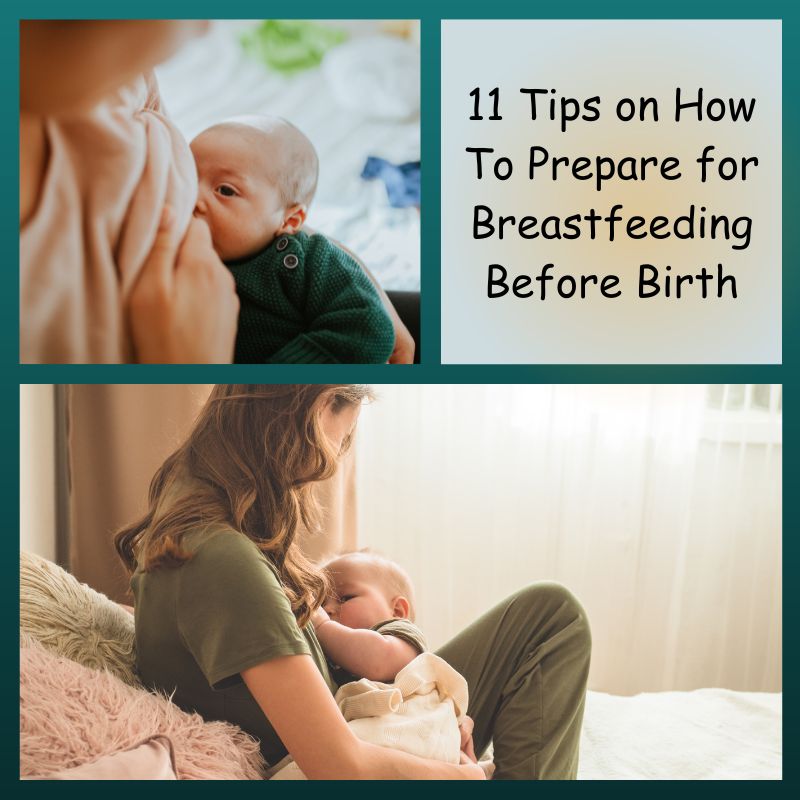Do you want to know how to prepare for breastfeeding before birth, and if it is even necessary? Nursing your little one is a natural and gratifying way to nourish your baby, but it can also be a journey that needs preparation, patience, and support. Preparing before your baby’s arrival can make the experience easier and more enjoyable. Below are strategies to help you prepare physically, mentally, and logistically for nursing.
11 Tips on How To Prepare For Breastfeeding Before Birth

1. Educate Yourself About Breastfeeding
Once you understand the basics of breastfeeding, your breastfeeding journey can be a lot easier. Researching and learning about the process can help you set realistic expectations and empower you to address challenges as they arise. Here are some ways to educate yourself:
- Attend Prenatal Breastfeeding Classes: Many hospitals, birthing centers, and community organizations have classes with certified lactation consultants. These classes offer valuable insights into latching techniques, nursing positions, milk production, and addressing common issues.
- Read Books and Articles: Books like The Womanly Art of Breastfeeding by La Leche League International or Breastfeeding Made Simple by Nancy Mohrbacher offer comprehensive guidance.
- Watch Videos: Visual learning through reputable online resources or YouTube channels can be beneficial for understanding techniques like achieving a proper latch or hand-expressing milk.
- Reach Out to Experienced Moms: Conversations with friends or family members who have breastfed can offer practical tips and emotional support.
2. Build a Support Network
Breastfeeding can be challenging, especially in the early weeks. A strong support network makes a significant difference:
- Partner Involvement: Discuss your breastfeeding plans with your partner so they understand your goals and how to support you. Partners can assist with household tasks, bring you water or snacks during nursing sessions, and offer emotional encouragement.
- Lactation Consultant: Identify a certified lactation consultant in your area before giving birth. Having their contact information ready can be invaluable if issues arise.
- Breastfeeding Support Groups: Join online or in-person breastfeeding communities where you can connect with other moms who are on the same journey.

3. Prepare Your Body
While your body is naturally designed for breastfeeding, a little preparation can help ensure a smoother experience:
- Nipple Care: While special nipple preparation is not strictly necessary for everyone, ensuring your nipples are clean and moisturized is beneficial. If you have flat or inverted nipples, consult a lactation consultant or your healthcare provider for guidance.
- Healthy Diet and Hydration: A balanced diet during pregnancy ensures you have the nutrients needed for milk production. Staying hydrated is equally important.
- Breast Health: Regularly check for lumps or tenderness, and consult your healthcare provider about any concerns.
4. Understand the Basics of Milk Production
Breast milk production is regulated by supply and demand. Knowing how your body makes milk can help you feel more confident:
- Colostrum: Your breasts start producing colostrum, a nutrient-rich pre-milk, during pregnancy. This is what your baby will consume in the first few days after birth.
- Milk Transition: Around 2-5 days postpartum, your milk “comes in.” This transitional milk eventually becomes mature milk.
- Frequent Nursing: The more your baby nurses, the more milk your body will produce. Early and frequent feedings help establish your milk supply.
Related: 11 Best Breastfeeding Tips For New Moms

5. Gather Essential Breastfeeding Supplies
While breastfeeding requires very little equipment, certain items can make the process more convenient and comfortable:
- Nursing Bras and Tops: Invest in comfortable, supportive nursing bras and easy-access tops or dresses.
- Nipple Cream: Lanolin-based creams or plant-based alternatives can soothe sore nipples.
- Nursing Pillow: A supportive pillow helps position your baby correctly and reduces strain on your back and arms.
- Breast Pump: Even if you plan to exclusively breastfeed, a pump can be useful for relieving engorgement, building a milk stash, or allowing others to feed the baby.
- Milk Storage Bags: These are essential if you plan to store expressed milk.
- Breast Pads: Reusable or disposable breast pads help absorb leaks.
- Bottle Feeding Supplies: If you plan to alternate between breastfeeding and bottle feeding, choose bottles designed to minimize nipple confusion.
6. Discuss Your Breastfeeding Plan with Your Healthcare Provider
Share your breastfeeding goals with your healthcare provider during prenatal visits. They can:
- Offer personalized advice based on your medical history.
- Address concerns such as previous breast surgeries, medications, or medical conditions that could affect breastfeeding.
- Help you establish a plan for skin-to-skin contact and breastfeeding initiation immediately after birth.

7. Plan for the Early Days Postpartum
The first few days after birth are crucial for establishing breastfeeding:
- Skin-to-Skin Contact: Holding your baby skin-to-skin immediately after birth stimulates their natural rooting reflex and encourages the first latch.
- Rooming-In: Staying in the same room as your baby allows you to respond promptly to their hunger cues, such as rooting or sucking motions.
- Avoiding Pacifiers and Bottles: Delay introducing pacifiers or bottles until breastfeeding is well established, usually around 3-4 weeks, to avoid nipple confusion.
Related: 19 Health Advantages of Breastfeeding You Should Know
8. Set Realistic Expectations
Breastfeeding is a learning process for both you and your baby. It’s normal to encounter challenges like:
- Cluster Feeding: Babies often feed frequently in the early days to help establish your milk supply.
- Latching Difficulties: It may take time and practice to achieve a deep latch.
- Engorgement or Soreness: These common issues can be managed with proper techniques and support.
9. Prepare Your Environment
Setting up a breastfeeding-friendly space can make nursing sessions more comfortable:
- Comfortable Seating: Choose a chair or spot with good back support.
- Nursing Station: Keep essentials like water, snacks, burp cloths, and your phone or a book within reach.
- Low Lighting: A dim, calming environment can help both you and your baby relax.

10. Know When to Seek Help
Sometimes, despite preparation, breastfeeding challenges arise. Signs that you may need professional support include:
- Painful latching or persistent nipple pain.
- Concerns about your baby’s weight gain.
- Signs of low milk supply or overproduction.
- Plugged ducts or symptoms of mastitis, such as redness, swelling, or fever.
11. Stay Flexible
While it’s important to have a plan, flexibility is equally vital. Every breastfeeding journey is unique, and some adjustments may be necessary. Be kind to yourself and celebrate every small victory along the way.
Conclusion
Preparing for breastfeeding before your baby’s arrival can ease your transition into this nurturing and bonding experience. By educating yourself, building a support system, and setting up a comfortable environment, you’ll be better equipped to handle the challenges and joys of breastfeeding.
Remember that help is available, and every step you take to prepare is an investment in your baby’s health and your own well-being. I hope these tips on how to prepare for breastfeeding before birth will guide you and make your nursing experience a little easier.





Be the first to reply